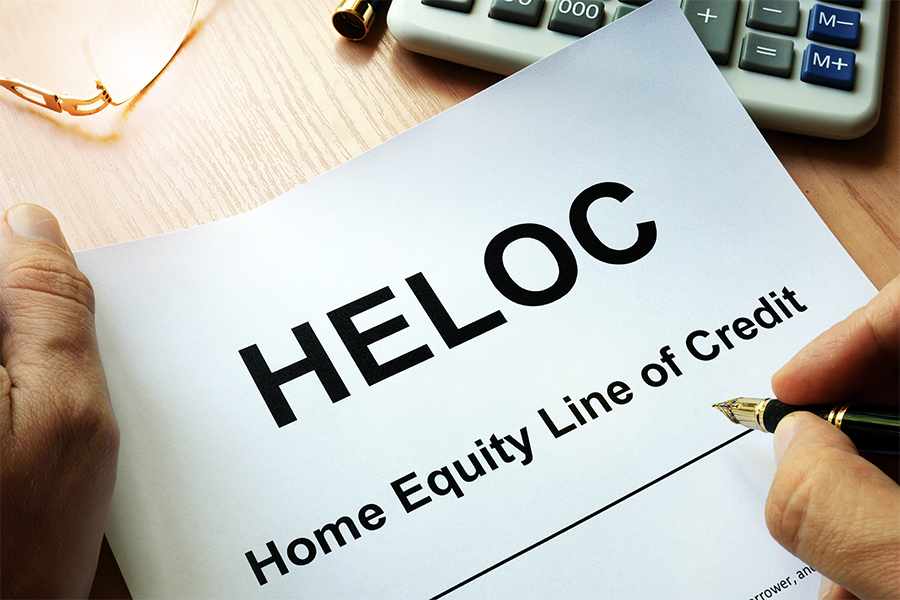
Small businesses with limited resources can use a home equity line of credit (HELOC) to help financially support their business. A HELOC is a revolving credit facility that provides quick access to funds and can be used to cover short-term expenses. Funds can be drawn on the line and repaid over a period of time. For newer businesses, they can be easier to obtain than traditional business loans due to fewer qualification requirements and being tied to the borrower’s home value and personal finances.
Key takeaways
- HELOCs are tied to the borrower’s home value and personal finances rather than business history and credentials.
- Flexible rates and repayment terms are available with a HELOC, and funds are drawn on an as-needed basis.
- Funds drawn on the line have flexible usage with little to no restrictions.
The following steps outline the process of how you can use a HELOC to help your business and how you can go about getting one.
Step 1: Understand How a HELOC Works
A HELOC is a type of line of credit that’s available to borrowers who own a home and have built sufficient equity. Its value is based on the stake in equity the borrower has, and the value of the home owned. Since it’s tied to the borrower’s home and finances, a HELOC provides a financing opportunity to business owners who may be ineligible for other forms of startup financing.
Obtaining a HELOC requires approval from a lender. Once you’ve applied and established the line of credit, you can draw upon the line and have the requested funds deposited into your account of choice. These funds have little to no restrictions as to how the funds can be used, therefore ideal for businesses who may use them for expenses related to their business operations.
There’s a draw period designated by the lender, most commonly 10 years, that allows the borrower to make purchases and repay the balance over time. Monthly payments are made based only on the outstanding balance of the loan, usually with a variable interest rate. The borrower can repay the balance and withdraw funds up to the loan limit on a recurring basis.
Understanding how a HELOC works is crucial to ensure it’s the best fit for your business. A HELOC can provide financing opportunities and a “safety net” to businesses that need funding to support their operations.
A HELOC differs from a home equity loan (HEL) in that the funds provided are drawn on an as-needed basis, rather than a lump sum to be paid off over time.
Step 2: Determine If You Qualify for a HELOC
Before pursuing a HELOC, you’ll want to make sure you’re eligible to meet the standard qualification criteria. Like many loans, lenders will determine creditworthiness based on personal income, credit score, debt-to-income ratio, and most importantly, your home value. The total credit limit available will be based on the total ownership percentage you have over your home, minus a mortgage. You can typically borrow up to 95% of the value of your home, depending on the lender.
Step 3: Check the Rates & Terms of a HELOC
When shopping around for a HELOC, consider if the standard rates and terms are within your budget. Credit amounts will vary depending on the value of your home, so when approaching lenders be sure to ask for a quote that represents your current home value and your ownership percentage.
The line of credit will be secured by the borrower’s home but, in some cases, the lender may request additional collateral. Almost all HELOCs have a variable interest rate for the lifetime of the loan and will adjust depending on the current market. Lastly, repayment terms can vary but, usually, the line is expected to be repaid in full within five to 10 years.
Keep in mind that, if you default on the loan, you’re personally liable for it. This includes putting your home at risk, along with your personal credibility. Make sure you’re comfortable with the risk, and if it’s worth the flexibility.
Step 4: Select a Lender for Your HELOC
Since a HELOC is attached to the home you own, you can utilize the same lender that provides your mortgage loan. While not always the case, it can help with the continuity of your finances and the lender may even offer a deal in which you receive a discount for favorable rates and terms.
However, more provider options are available, such as online lenders or other banks near you. Check out the following resources:
- LendingTree: LendingTree is an online resource that can help you compare rates and terms from various lenders with a single application.
- U.S. Bank: U.S. Bank offers both variable- and fixed-rate options, no application fees or closing costs, and favorable loan rates and terms.
- Bank of America: Bank of America is a lender that offers introductory low rates and discounts, no closing or annual fees, and a free application process.
Step 5: Apply for a HELOC
Applying for a HELOC is a relatively straightforward process, and you’ll need to provide documentation to the lender pertaining to your personal financials. Along with the application materials, you’ll likely need to provide a net worth statement and a few years’ worth of tax returns.
Upon approval, the lender will require a valuation of your home via an appraisal and title work. Once all proper documentation has been received, the lender will establish the loan and you can begin to draw on the line. From start to finish, the process usually takes between 30 to 45 days.
Who a HELOC Is Right For
Getting a HELOC for business can provide for a wide variety of uses. It’s a financial tool that can benefit businesses of all sizes, and may be a fit for your business if:
- You need startup capital: If you’re a new startup or small business, a HELOC can provide quick access to capital that can help your business take off, whether it be for inventory purchases, fixtures, equipment, or something else. HELOCs provide an alternative to getting a traditional small business loan and allow flexibility in repayment, which is particularly useful to businesses with limited experience and resources.
- You’re building an emergency fund: Unplanned expenses are common when running a business, and a HELOC can provide a financial cushion in the event of emergencies and help mitigate the risk of your business operations should anything happen out of the blue.
- You can benefit from short-term financing: Short-term expenses, such as renovations and repairs, can be financed with a HELOC. Since they generally have variable interest rates and flexible repayment terms, they can be useful for businesses that need to make a large purchase without being locked into a traditional loan to finance it.
Pros & Cons of a HELOC
Alternatives to a HELOC
If you think a HELOC may not be suitable for your business needs, there are plenty of alternatives to explore that can help fund your business:
- Small business credit cards: Similar to a line of credit, a business credit card can provide quick access to funds and be used to simply make a purchase on the card rather than drawing on a line and waiting for the deposit.
- Business lines of credit: This revolving credit facility is provided to eligible businesses who can draw on the line, have the funds deposited, and repay the balance over a period of time.
- Small Business Administration (SBA) loans: For businesses with a strong credit history, an SBA loan can be a viable option for businesses making larger purchases and seeking structured financing with favorable interest rates and terms.
- Crowdfunding: For startups sourcing seed money for their business, crowdfunding allows investors and donors to contribute funds in the early stages of business development.
- Startup financing: If you need to make a large purchase or finance an asset long-term, there are various forms of startup financing that can assist you—whether it be through equipment financing or other startup business loans.
Frequently Asked Questions (FAQs)
Repayment periods can vary depending on the lender but, generally, once the draw period has ended, the borrower has between five to ten years to repay the loan balance.
Yes. Since qualifying for a HELOC is dependent on your personal financial circumstances rather than the credibility of your business, you can obtain a HELOC and use the funds accordingly.
Most HELOCs apply a variable interest rate strictly to the current balance of the loan. Variable interest rates will be adjusted whenever the rate is updated by the provider.
Bottom Line
A revolving line of credit, such as a HELOC for business, is a financial tool available to businesses across all industries. It can provide financial support and aid in the overall success of your business. It’s accessible to new small and startup businesses who have limited resources since qualifying is based on personal factors, such as income, home ownership, and credit. However, it’s important to keep in mind that if you were to default on the loan, your home and personal credit can be at risk.
Now that you know how to use a HELOC for business, make sure to explore all options before determining it’s the best fit for you.





